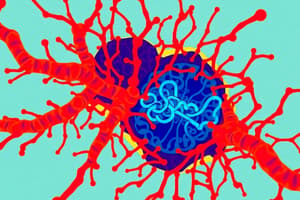Podcast
Questions and Answers
Which of the following best describes the central theme of vesicular transport?
Which of the following best describes the central theme of vesicular transport?
- The synthesis of ATP in the mitochondria.
- The random movement of molecules within the cell.
- The degradation of misfolded proteins in the endoplasmic reticulum.
- The selective movement of molecules between different cellular compartments. (correct)
What is the primary role of adaptor proteins in clathrin-coated vesicles?
What is the primary role of adaptor proteins in clathrin-coated vesicles?
- To remove the clathrin coat after vesicle formation.
- To provide the mechanical force for vesicle budding.
- To hydrolyze GTP and regulate the vesicle formation.
- To select and bind specific cargo receptors for incorporation into the vesicle. (correct)
Sar1-GTP is essential for the formation of COPII-coated vesicles. What is the direct role of guanine nucleotide exchange factor (GEF) in this process?
Sar1-GTP is essential for the formation of COPII-coated vesicles. What is the direct role of guanine nucleotide exchange factor (GEF) in this process?
- GEF recruits cargo molecules into the forming vesicle.
- GEF stimulates the GTPase activity of Sar1, leading to coat disassembly.
- GEF directly binds to the ER membrane to initiate vesicle budding.
- GEF facilitates the exchange of GDP for GTP on Sar1, activating it. (correct)
What quality checkpoint is used to determine when proteins can exit the endoplasmic reticulum (ER)?
What quality checkpoint is used to determine when proteins can exit the endoplasmic reticulum (ER)?
Which of the following best describes the function of NSF in vesicular transport?
Which of the following best describes the function of NSF in vesicular transport?
How does botulinum toxin interrupt vesicular targeting?
How does botulinum toxin interrupt vesicular targeting?
What is the key difference between homotypic and heterotypic membrane fusion?
What is the key difference between homotypic and heterotypic membrane fusion?
What is the primary purpose of the KDEL sequence in ER-resident proteins?
What is the primary purpose of the KDEL sequence in ER-resident proteins?
In which cellular location is the Golgi apparatus typically observed?
In which cellular location is the Golgi apparatus typically observed?
What is the function of protein glycosylation?
What is the function of protein glycosylation?
How do hydrolases, destined for the lysosome, reach their target compartment?
How do hydrolases, destined for the lysosome, reach their target compartment?
Which of the following best describes lysosomal storage diseases?
Which of the following best describes lysosomal storage diseases?
What is the role of LDL receptors in endocytosis?
What is the role of LDL receptors in endocytosis?
What happens to endocytosed receptors after they are internalized?
What happens to endocytosed receptors after they are internalized?
What must occur before exocytosis can proceed?
What must occur before exocytosis can proceed?
How does a plant vacuole differ functionally from a lysosome in animal cells?
How does a plant vacuole differ functionally from a lysosome in animal cells?
Which of the following best describes the role of dynamin GTPase in clathrin-mediated endocytosis?
Which of the following best describes the role of dynamin GTPase in clathrin-mediated endocytosis?
What is the implication of homotypic fusion occurring between vesicles coming off the ER?
What is the implication of homotypic fusion occurring between vesicles coming off the ER?
Which of the following is an example of a disease that results from LDL receptor malfunction?
Which of the following is an example of a disease that results from LDL receptor malfunction?
What is the role of GlcNAc phosphotransferase in the context of lysosomal hydrolase targeting?
What is the role of GlcNAc phosphotransferase in the context of lysosomal hydrolase targeting?
Flashcards
Vesicular Transport
Vesicular Transport
Movement of molecules within a cell via membrane-bound vesicles.
Major Vesicular Transport Pathways
Major Vesicular Transport Pathways
Endocytic, biosynthetic/secretory, and retrieval pathways.
Clathrin-Coated Vesicle
Clathrin-Coated Vesicle
Vesicles coated with clathrin; involved in transport from the trans-Golgi network and plasma membrane to endosomes.
Clathrin Vesicle Components
Clathrin Vesicle Components
Signup and view all the flashcards
COPII-Coated Vesicle
COPII-Coated Vesicle
Signup and view all the flashcards
COPII Vesicle Components
COPII Vesicle Components
Signup and view all the flashcards
Vesicle Targeting
Vesicle Targeting
Signup and view all the flashcards
Key Targeting Proteins
Key Targeting Proteins
Signup and view all the flashcards
Homotypic Fusion
Homotypic Fusion
Signup and view all the flashcards
Heterotypic Fusion
Heterotypic Fusion
Signup and view all the flashcards
Protein Transport
Protein Transport
Signup and view all the flashcards
Golgi Apparatus
Golgi Apparatus
Signup and view all the flashcards
Protein Glycosylation
Protein Glycosylation
Signup and view all the flashcards
Types of Glycosylation
Types of Glycosylation
Signup and view all the flashcards
Lysosome and Vacuole
Lysosome and Vacuole
Signup and view all the flashcards
Lysosomal Targeting
Lysosomal Targeting
Signup and view all the flashcards
Lysosomal Storage Diseases
Lysosomal Storage Diseases
Signup and view all the flashcards
Endocytosis
Endocytosis
Signup and view all the flashcards
Types of Endocytosis
Types of Endocytosis
Signup and view all the flashcards
Secretory Pathways
Secretory Pathways
Signup and view all the flashcards
Study Notes
- Central theme of vesicular transport is moving materials in and out of cells
Major Pathways of Vesicular Transport
- Vesicular transport involves 3 major pathways
Clathrin-Coated Vesicles
- Donor and target compartments are needed in their description
- Triskelion, adaptor proteins, and cargo receptors are needed in functional descriptions
- Dynamin GTPase, PIP phosphatase, Hsp70, and auxillin are also needed in functional descriptions
COPII-Coated Vesicles
- Donor and target compartments are needed in its description
- Sar1, GEF, Sec23, Sec24, Sec13, and Sec31 are needed in functional descriptions
- Quality check point to determine when proteins exit the ER
COPI-Coated Vesicles
- Donor and target compartments are needed
Vesicle Targeting
- Vesicles are marked so they get to the proper target compartment
- v-SNARE, t-SNARE, Rabs, tethering protein, and NSF are needed in functional descriptions
- Botulism toxin interrupts vesicular targeting
Membrane Fusion
- Heterotypic and homotypic membrane fusion are defined
- Process of homotypic membrane fusion with results from vesicles coming off the ER is described
Protein Transport
- Describes how proteins go from the ER to the Golgi apparatus and from the Golgi apparatus back to ER
- States the signal retrieval and name for this type of transport
Golgi Apparatus
- The cis- and trans- faces are described
- States the 4 target compartments where vesicles coming from the Golgi apparatus may go
- States where the Golgi apparatus may be observed
Protein Processing in the Golgi Apparatus
- The protein processing that can occur in the Golgi apparatus is described
- N-linked oligosaccharides are defined and lists 2 classes of N-linked oligosaccharides that may be added to proteins
- O-linked oligosaccharides are defined
- Some functions of protein glycosylation are described
Lysosomes and Plant Vacuoles
- Gives functional descriptions of a lysosome and a plant vacuole
- How the necessary proteins for lysosome function arrive at the lysosome is described using a hydrolase as an example
- Describes the signals involved and the functional descriptions of M6P and GlcNac phosphotransferase
Lysosomal Storage Diseases
- Gives a general description of a lysosomal storage disease and specific information on what functional enzyme is lacking in the specified lysosomal storage diseases
Endocytosis
- Lists and completely describes the three types of endocytosis
- Includes in description the proteins and vesicles that are involved Use LDL reception, uptake, and receptor recycling as an example
- Describes the disease that results from LDL receptor malfunction
Endocytosed Receptors
- Describes the 3 fates of endocytosed receptors
Secretory Pathways
- Describes the two secretory pathways and what must occur before exocytosis can occur
Studying That Suits You
Use AI to generate personalized quizzes and flashcards to suit your learning preferences.





